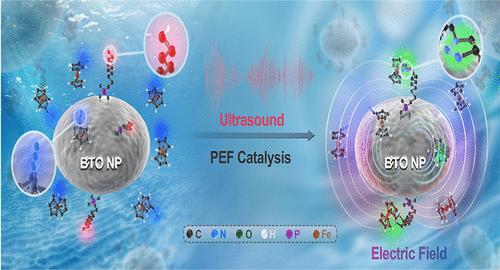Piezoelectrostatic Catalysis of the Azide–Alkyne Huisgen Cycloaddition
IF 14.4
1区 化学
Q1 CHEMISTRY, MULTIDISCIPLINARY
引用次数: 0
Abstract
Electric fields are increasingly recognized for their role as ‘smart reagents’ that can trigger or accelerate chemical reactions. Expanding upon this concept, our research introduces an innovative method that exploits electric fields induced by ultrasound on piezoelectric nanoparticles to facilitate the azide–alkyne Huisgen cycloaddition in nonaqueous environments. The intense electric field generated around the BaTiO3 nanoparticles, as supported by density functional theory calculations, provides the suitable conditions necessary to trigger the cycloaddition of the alkyne-functionalized nanoparticles and the azide present in the solution. To quantitatively assess the occurrence of the click cycloaddition reaction at the nanoparticle surface interface, we tacked the azide with either an electroactive ferrocene moiety or with gold nanoparticles, which act as surface Raman enhancers. These experiments not only provide experimental validation of our approach, but also highlights the potential of piezoelectrostatic catalysts in enhancing the scalability of electrostatic catalysis.

叠氮-炔烃 Huisgen 环加成的压电催化反应
本文章由计算机程序翻译,如有差异,请以英文原文为准。
求助全文
约1分钟内获得全文
求助全文
来源期刊
CiteScore
24.40
自引率
6.00%
发文量
2398
审稿时长
1.6 months
期刊介绍:
The flagship journal of the American Chemical Society, known as the Journal of the American Chemical Society (JACS), has been a prestigious publication since its establishment in 1879. It holds a preeminent position in the field of chemistry and related interdisciplinary sciences. JACS is committed to disseminating cutting-edge research papers, covering a wide range of topics, and encompasses approximately 19,000 pages of Articles, Communications, and Perspectives annually. With a weekly publication frequency, JACS plays a vital role in advancing the field of chemistry by providing essential research.

 求助内容:
求助内容: 应助结果提醒方式:
应助结果提醒方式:


